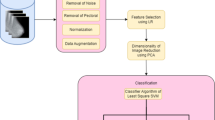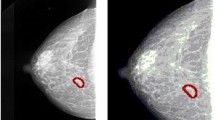Abstract
Many pattern recognition and machine learning methods have been used in cancer diagnosis. In this study, we propose a kernel orthogonal transform method for breast cancer diagnosis. We test our method using the widely used Wisconsin breast cancer diagnosis (WBCD) dataset. The performance of the method is evaluated in terms of the classification accuracy, specificity, positive and negative predictive values, as well as receiver-operating characteristic curve (ROC). The experimental results show that our method classifies more accurately than all of the previous methods.




Similar content being viewed by others
References
Kıyan T, Yıldırım T (2003) Breast cancer diagnosis using statistical neural networks, XII. In: TAINN symposium proceedings, E(8)
West D, Mangiameli P, Rampal R, West V (2005) Ensemble strategies for a medical diagnosis decision support system: a breast cancer diagnosis. Eur J Oper Res 162:532–551
Xu Y, Yang JY, Yang J (2004) A reformative kernel fisher discriminant analysis. Pattern Recogn 37:1299–1302
Parkin DM, Bray F, Ferlay J, Pisani P (2005) Global cancer statistics. CA Cancer J Clin 55:74–108
Quinlan JR (1996) Improved use of continuous attributes in C4.5. J Artific Intell Res 4:77–90
Abonyi J, Szeifert F (2003) Supervised fuzzy clustering for the identification of fuzzy classifiers. Pattern Recognit Lett 24:2195–2207
Nauck D, Kruse R (1999) Obtaining interpretable fuzzy classification rules from medical data. Artif Intell Med 16:149–169
Hamilton HJ, Shan N, Cercone N (1996) RIAC: a rule induction algorithm based on approximate classification, Technical Report CS 96-06, University of Regina
Ster B, Dobnikar A (1996) Neural networks in medical diagnosis: comparison with other methods. In: Proceedings of the international conference on engineering applications of neural networks, pp 427–430
Bennet KP, Blue JA (1997) A support vector machine approach to decision trees. Math Report, No. 97-100, Rensselaer Polytechnic Institute
Akay MF (2009) Support vector machines combined with feature selection for breast cancer diagnosis. Expert Syst Appl 36:3240–3247
Wang J, You J, Li Q, Xu Y (2011) orthogonal discriminant vectors for face recognition across pose, Pattern Recognition (in press)
Schölkopf B et al (1999) Input space versus feature space in kernel-based methods. IEEE Trans Neural Netw 10(5):1000–1017
Acknowledgments
This article is partly supported by Program for New Century Excellent Talents in University (Nos. NCET-08-0156 and NCET-08-0155), NSFC under grants No. 61071179, 60803090, 60902099, and 61001037, as well as the Fundamental Research Funds for the Central Universities (HIT.NSRIF. 2009130).
Author information
Authors and Affiliations
Corresponding author
Rights and permissions
About this article
Cite this article
Xu, Y., Zhu, Q. & Wang, J. Breast cancer diagnosis based on a kernel orthogonal transform. Neural Comput & Applic 21, 1865–1870 (2012). https://doi.org/10.1007/s00521-011-0547-0
Received:
Accepted:
Published:
Issue Date:
DOI: https://doi.org/10.1007/s00521-011-0547-0




